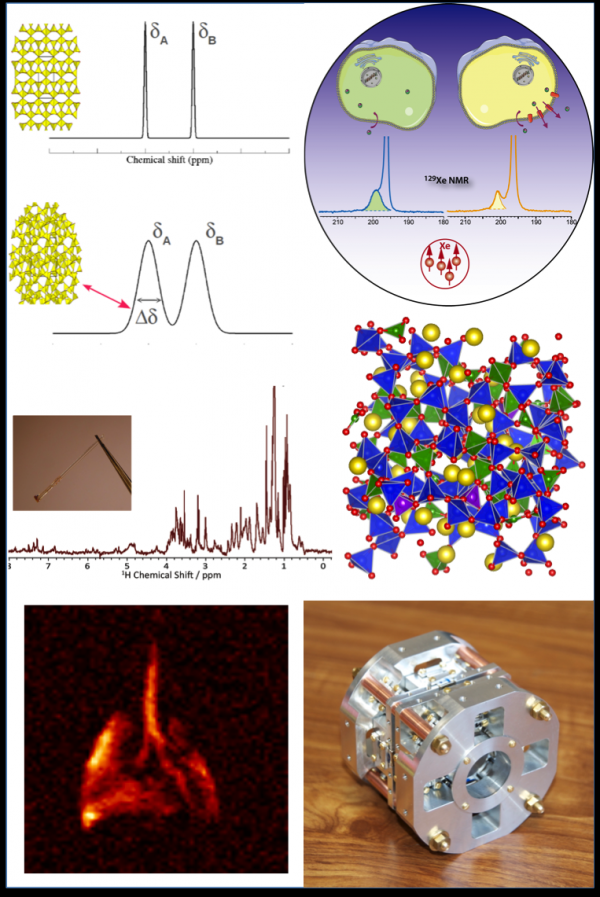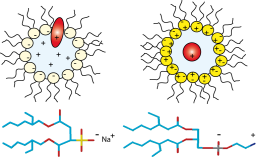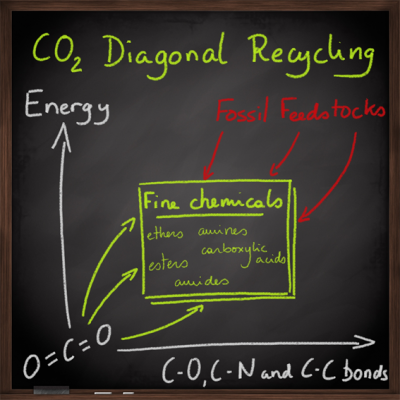Pages scientifiques 2011
The Laboratory 'Structure and Dynamics by Magnetic Resonance' (LSDRM) belongs to NIMBE, UMR CEA/CNRS 3685.
The research axes are centered on the conception and the use of new NMR tools. Cutting edge methods and original approaches are proposed, from instrumental developments to molecular simulations. The applications cover a large field from the gas to the solid phase, from spectroscopy to imaging, for a better knowledge of the fine structure of materials such as nuclear glasses or biological macromolecules. A strong support in Quantum Chemistry is required for an in-depth study of these different fields.
Research themes
High resolution NMR fails in the case of large macromolecules (molecular size >35 kDa) due to slow tumbling which results in short relaxation time T2 and signal loss during pulse sequences, even for proteins enriched in stable isotopes (15N, 13C, 2H), and in spite of the experiments using cross correlation effects (TROSY, CRINEPT).
Prediction of long term corrosion (on several hundred years) of low alloy steels is a crucial issue in several research domains: metallic cultural heritage conservation, civil engeeniring, etc. Recent results demonstrate that, despite the corrosion layers could reach several millimetre thicknesses, the kinetics can be controlled at the nanoscale (presence of barrier layer at the metal/oxide interface, influence of crystallinity in the electrochemical reactivity, etc). For that reason, in addition to micrometer scale investigation it is now necessary to characterise these complex systems at the nanometer scale. In addition to classical TEM methods, the appearance of new synchrotron based techniques as Scanning Transmission Xray Microsopy, opens the door to new kind of chemical (atoms environments) and structural investigations at the nanoscale, in the field of corrosion.
First investigations were conducted iron nails, coming from the 16th century archaeological site of Glinet. This site is a reference one for long term corrosion studies since about 10 years and present desaerated calco-carbonated water saturated soil. The metal oxide interface was investigated, focusing on the detection on specific barrier layers that could play a crucial role in the corrosion mechanisms..
After classical observations at the microscopic scale (SEM, µRaman spectroscopy,...) both samples sets, (were observed on thin films of the transverse sections prepared by FIB. A fine elementary and structural description of the interfaces between metal and corrosion products in the nails has been obtained by TEM- and STXM. Chemical and structural maps (atom environments) were provided at the nanoscale. STXM experiments have been performed at Pollux beamline at Swiss Light Source synchrotron on these alteration layers in order to determine the nature of the phases formed.
Les énergies fossiles (pétrole, gaz et charbon) représentent 85 % des besoins énergétiques mondiaux et leurs combustions constituent la première source d’émission de gaz à effets de serre notamment pour le dioxyde de carbone (CO2). Dans les prochaines décennies, les industries fortement consommatrices de ces ressources fossiles, comme celles de la chimie et des carburants, vont faire face à des défis importants pour minimiser leur impact environnemental. Elles devront ainsi utiliser des sources de carbones renouvelables. Pour résoudre cette antinomie entre les aspects économiques et écologiques, de nouvelles méthodes de recyclage du CO2 doivent être découvertes, afin d’utiliser ce déchet comme source primaire de carbone pour la production de consommables organiques (plastiques, engrais, …) et pour la production de carburants basés sur les énergies décarbonées.
Pour répondre à ces problématiques, le Laboratoire de Chimie Moléculaire et Catalyse pour l'Energie (LCMCE) du NIMBE porte une thématique visant le développement de nouveaux catalyseurs et procédés catalytiques pour le recyclage chimique du CO2.












 Version française
Version française


